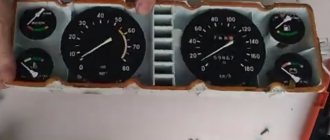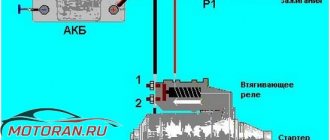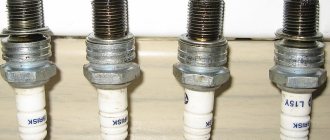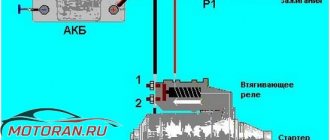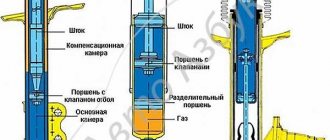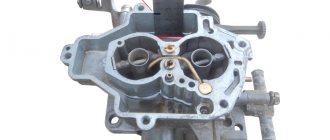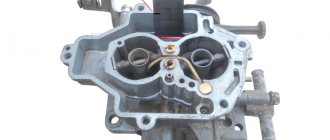Reasons for failure of one of the cylinders
The engine can begin to trouble for several reasons and it is quite difficult to immediately diagnose the problem; it is recommended to start checking with the most harmless parts, following the list below.
The engine on a VAZ 2107 may triple for the following reasons:
- Worn spark plugs;
- Wear of high-voltage wires;
- Clogged filters;
- Problems with the fuel supply (clogged carburetor or injectors);
- The ignition has gone wrong (relevant for carburetor engines);
- Failure in the ignition module or DPKV (relevant for fuel-injected cars);
- Air leak in the system;
- Valve clearances are off;
- The cylinder head gasket was blown;
- CPG wear;
As you can see, this list contains problems of increasing severity. If your car shows signs of shaking, then checking and searching for the cause must be carried out using this list.
Checking the ignition coil (babin) of VAZ 2106
And now we have finally come to the ignition coil of the VAZ 2106. If the ignition coil is faulty, then there will not be a spark in all cylinders at once, this needs to be understood. Those. the engine will not start. How can I check it? There are several ways, but I will tell you about one, the simplest one - this is measuring the resistance of the primary and secondary windings of the coil. Let's start with the primary one. To do this, set the tester in resistance measurement mode and measure it between the “+” and “-” terminals of the coil. It should be between 0.5 and 2 ohms. If the tester does not show anything, it means the circuit is broken and the coil needs to be replaced.
Next, we measure the secondary winding - between the “+” and the central terminals of the coil. Allowable resistance is up to 15 kOhm.
This ends the high-voltage part of the KSZ and now I will make some amendments for the BSZ VAZ 2106.
The main differences are that instead of a chopper with a capacitor, a Hall sensor with a switch is installed.
Solutions to the problem
To solve the problem on your own, a motorist needs to have not only a mechanic’s tool, but also a little skill in car repair. Below is a list of all possible methods for eliminating the problem of a VAZ 2107 engine stalling.
Spark plug
When tripping occurs (failure of one of the cylinders), first of all it is necessary to check the spark plugs, since they directly affect the performance of the cylinders. Quite often it happens that one of the spark plugs fails, thereby not supplying a spark to the cylinder, which leads to misfire of the fuel mixture and, accordingly, engine throttling.
If the engine on a VAZ 2107 starts to fail, the first thing you need to do is check the spark plugs, and if they have not been changed for a long time, then it is recommended to replace them with new ones; this will never be a bad idea.
High voltage wires
After spark plugs, it is necessary to check the high-voltage wires from the distributor or ignition module (depending on the type of engine - injector or carburetor). The wires are made of special silicone with high insulation resistance, inside which there is a conductor with low resistance, through which an electric current flows, having a high voltage reaching 15 kV.
When the wires wear out, abrasions appear due to friction against the engine body, their insulation is damaged and a voltage breakdown on the engine body is possible, which will lead to misfire in the cylinder to which this wire is connected and, consequently, to engine misfiring.
Filter
To ensure long engine operation, the car uses various types of filters that help purify the air and fuel that enters the cylinders. It happens that clogged filters can affect the operation of the engine; this, of course, will not cause a failure of the cylinders, but will significantly reduce the number of engine revolutions at idle, which can be confused with the failure of one of the cylinders.
If there is any suspicion of engine trouble, it is necessary to check all the filters of the car and, if necessary, replace them with new ones.
Fuel supply
Due to poor quality fuel or clogged filters, a fuel supply interruption may occur. If the engine is carburetor, then the engine will not work steadily and the speed will drop, but this will not cause the failure of any of the cylinders, since the carburetor is responsible for the operation of all 4 cylinders at once, but in the VAZ 2107 injection engine, a blockage in the fuel system can cause the engine to trip.
The 7's injection engine has injectors installed on each cylinder; it happens that debris with fuel gets into the injectors and clogs them. If one of the injectors is clogged, this can seriously affect the operation of the cylinder into which the clogged injector supplies fuel.
To determine whether the injectors are clogged, you need to measure the fuel pressure, then turn on each of the injectors one by one using diagnostic equipment and see how much the fuel pressure drops; on all 4 injectors, the diesel fuel pressure should drop by an equal number of divisions.
If the readings on one of the injectors vary less, this indicates that it is clogged.
Clogged injectors simply need to be washed and replaced.
Ignition problems
This problem is relevant only for carburetor engines, since in an injection engine the ignition is set automatically using special sensors.
Quite often, the ignition on the distributor goes wrong, or the distributor (runner) breaks through, which leads to engine failure. But when the ignition timing is lost and then the spark may not be supplied at the right moment, but late or, conversely, earlier than expected, this will lead to improper combustion of the fuel mixture and misfires.
Ignition module and DPKV
This problem only occurs on injection engines, since carburetor engines do not have an ignition module (IM). A module is a part that produces a spark to operate all 4 cylinders of a car. Inside the module there are two coils responsible for the operation of a pair of cylinders (1-4), (2-3). It happens that one of the coils may fail, then two cylinders fail at once and it turns out that the engine “doubles”. If two cylinders fail at once on your car, then 80% is a breakdown in the ignition module.
Air leak
For the engine to operate properly, the proportions of fuel and air must be maintained; when these proportions are violated, the engine begins to operate unstably and incorrectly. A violation of the proportions can be caused by air leaks in the system of one of the cylinders, then this will cause the engine to trip.
The suction can be:
- Near the intake receiver at the junction with the cylinder head;
- After DMRV;
- On the sealing rings of the injectors;
- On the throttle assembly;
Valve clearances
Due to the design of the VAZ 2107 engine, there is a frequent need for valve adjustment. Many people forget about this and simply do not carry out this procedure on time, and this can lead to serious damage to the cylinder head. If you do not adjust the valves for a long time, they may become pinched and a gap will appear between the valve and the head; through this gap, hot gases will penetrate into the cylinder head, which will cause burnout of the valve, which will lead to inevitable repair of the cylinder head.
If the engine starts to stall, then one of the reasons may be a stuck valve or a burnt-out valve. In order to check this, it is necessary to measure the compression in the engine; if it is negligible or even zero, then the valve is definitely clamped.
Cylinder head gasket failure
Between the cylinder block and its head there is a special heat-resistant gasket that seals the cylinder and combustion chamber. It happens that due to overheating or old age, the gasket can be pierced between two cylinders or between the cylinder and the cooling jacket. This problem will cause a loss of compression in the cylinder, and the coolant in the tank will bubble if there is a breakdown between the cylinder and the cylinder head jacket.
CPG wear
This problem occurs in cars with fairly high mileage, when the piston fills an ellipse in the cylinder block and the piston rings wear out. All this significantly affects the compression ratio in the combustion chamber, compression drops, and the air-fuel mixture simply does not compress and ignite properly. Such consequences lead to misfires and engine tripping.
Checking explosive wires and spark plugs of VAZ 2106
The wire can be checked by measuring its resistance. At a minimum, there must be some resistance in the wire. As a maximum, it should not be too large, i.e. resistance in the range of 0.3 - 0.5 kOhm will be normal. If the tester shows nothing, i.e. a break means that the wire is not working and needs to be replaced. You can also check the wire by swapping it with a wire from another working cylinder.
The spark plug should have a normal gap of 0.7-0.8 mm. The candle must be clean - not in oil, not in black soot. An ideal candle has a slightly brownish coating. (More about spark plugs here) But naturally, if you unscrew a spark plug from a non-working cylinder, it will be clogged. Such a candle can be heated over an open fire so that all the deposits burn out and try to be installed in the engine. To be 100% sure that the problem is not in the spark plug, it is better to install a new or known working spark plug. If the problem does not go away, then we check further.
Valves and piston
These systems are tested together. First you need to remove the breather hose from the manifold. If white smoke comes from it, then the cause of the cylinder failure is definitely the piston. You should disassemble the engine and see what happened.
Most often, the rings are stuck; to eliminate them, you will have to remove the pistons. If there is no smoke, or it is almost colorless, then the problem is in the valves. First, let's measure the compression. If it is less than 11, then the diagnosis is a burnt valve. You will have to remove the head, change the valve and grind it in. If everything is fine with compression, remove the engine cover and check the valve adjustment. The engine can fail either because the valve is tight or because it is too loose. In any case, they need to be adjusted.
Other faults
Other breakdowns that are caused by the engine running hot include:
- Faulty valves
- Worn air filter
- Dirty throttle valve
- Failure of one of the sensors or interruptions in the operation of the computer
You will have to do a lot of work to find the problem area in the car system. But, by the method of elimination, I am sure that you will cope with the task in the shortest possible time. Good luck in all your endeavors.
Determining the location of the breakdown
First of all, you should make sure that it is the VAZ 2107 carburetor that creates the failures, after which you can disassemble it and take measures. Failure in engine operation with a sharp increase in speed can also be caused by parts of other components:
- bad spark plugs;
- malfunction in the contact ignition system.
Typically, worn-out spark plugs do not fail immediately, but die out as the pressure in the cylinders increases. That is, at idle and low speeds the spark plug produces a normal spark, but at high speeds, when the piston manages to create high pressure, the spark appears every once in a while or disappears altogether. The same effect is observed when the throttle valves are opened sharply: the pressure in the cylinders increases, the spark goes out, and the car, instead of dynamic acceleration, goes into failure.
It is quite simple to make sure that dips appear due to candles. When you do not have the opportunity to test them under pressure, you need to replace them with a working or new set, and then check the “classics” on the go.
If everything is in order with the spark plugs, in cars with a contact ignition system you need to check the distributor elements, which may cause failures:
- Make sure that the contacts are not burnt and clean them with a file. If a recess has burned out on one of the contacts, and a protrusion has formed on the other, then the part must be replaced.
- Check the operation of the ignition timing vacuum diaphragm connected to the carburetor by a tube. You should remove the distributor cap and disconnect the tube from the carburetor, and then draw air through it with your mouth. A working diaphragm will sharply pull the contact group towards itself using a lever.
An important point: failures are more often caused by the spark plugs and the ignition system than by the carburetor, so it is recommended to check them first. When the diagnosis of the listed elements does not give a positive result, you can safely move on to the carburetor.


